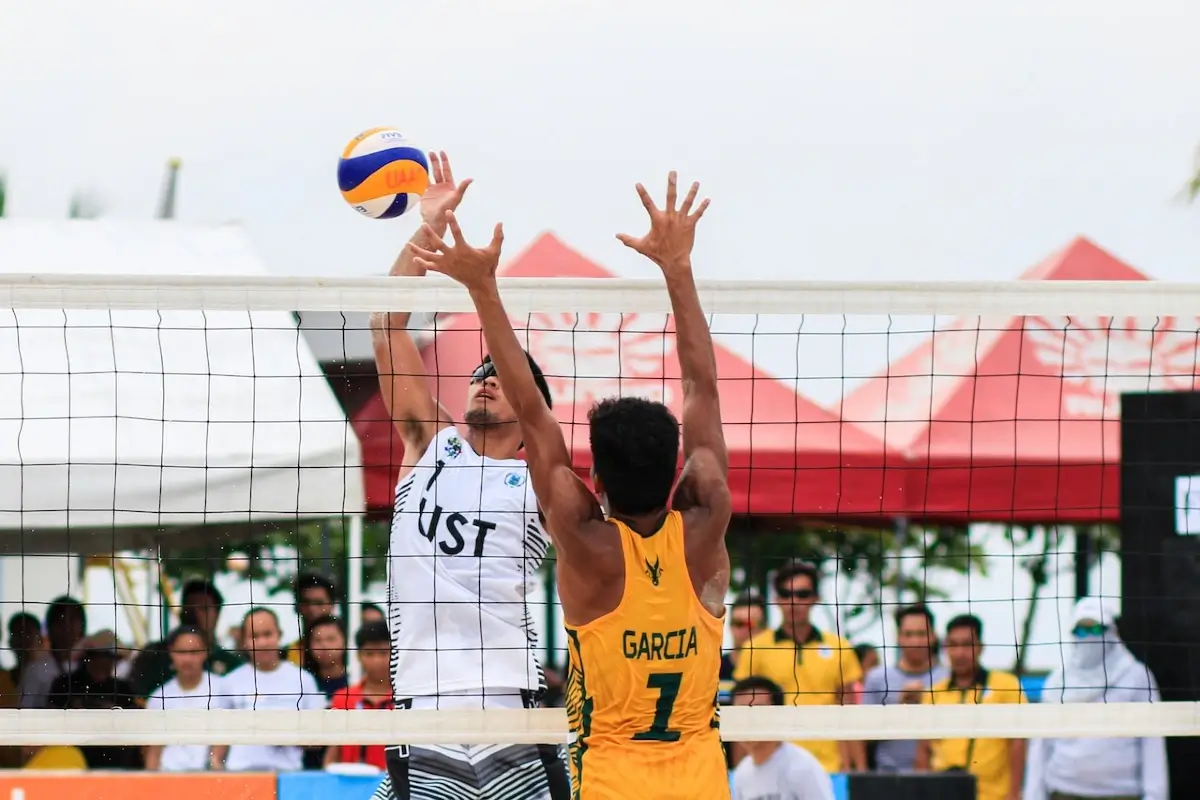Last Updated: October 19, 2023
You need to have a good defense mechanism for your team to have a fighting chance in the game of volleyball. Blocking is a difficult skill that requires the best level of training possible to be accomplished perfectly.
This guide to blocking and defense will be handy for beginner and expert volleyball players.
Good blocking requires accurate timing, proper body positioning, and movement. Coordinate your feet, arms, hips, shoulders, and visual acuity to make a successful block. Monitor your opposing team’s setter closely, predict the ball’s direction, and keep constant communication with the other blocker. This helps you to make a better attack in defense.
What Does Blocking Involve?

A blocker is required to deflect a ball coming from the opponent’s team back to their court. So, as a blocker, you try to guard your zone by keeping the ball out. If you cannot deflect the ball back to the other side, form a wall for your defense players on the backcourt to figure out what action to take.
Where to Block in Volleyball?
When blocking a ball, these are the main areas you should aim to cover.
Blocking the Line
This is hitting the line or an area inside your opponent’s court corresponding to the sideline you intend the ball to contact. For example, a right-side hitter’s closest sideline on your opponent’s court will be in zone 4. But for a left-side hitter, the zone 2 sideline should be your target as it will be nearer to you.
Blocking Cross-Court
This is where you hit the ball toward the end line or sideline that’s furthest from you but inside the opponent’s court. Zone 2 will be the furthest sideline for the right-side hitter, while zone 4 will be the furthest sideline for the hitter on the left side.
Efficient Tactics to Improve Your Blocking
After learning how to perform the blocking skill in volleyball, you must work towards making the skill beneficial to your team for a win.
Identify the Attackers
Any great blocker should visually identify the angle the ball is coming from and its intended contact area. This puts you in a position to block the ball easily. You should identify the position of the opposing setter in the back row or front row to make an informed defense.
Prepare to Block
Get a comfortable stance off the net. Place your arms in front, but be ready to move up, sideways or forward if necessary.
Put Hands Up and Fingers Wide
Although raising your hands is vital when blocking, it won’t attain much success if you don’t position your fingers correctly. Spread all five fingers out to form a wide area for blocking the ball. The fingers won’t be strong enough to make a powerful block when they are closer.
Related: Are You Making These Blocking Mistakes?
Keeping your hands up allows easy jumping, unlike when they are on your sides, as you might brush them with the net.
Know the Types of Sets to Expect
It would help if you understood the different sets a hitter will likely hit. Recognizing the set coupled with some knowledge of the attacker gives you an upper hand in blocking.
Here are the basic types of sets to expect:
- Outside set
- Inside set
- Set off the net (backcourt pipe/D)
- Tip situation
Penetrate the Net
For a block to be successful, the ball has to penetrate over the net, commonly known as counter-attacking. You aim to pass the ball over the net while ensuring it falls within your opponent’s court.
Body Positioning Tips to Practice Blocking
Hand Positioning
Create a “natural grab” with your hands around the ball by placing them slightly next to each other. Next, turn the hands slightly to point toward your desired direction to make a line or angle shot. If you place your hands too wide, the ball can pass through.
Finger Positioning
Spread your fingers wide apart when blocking. This makes the fingers stronger and take up more space for easy blocking. Failure to do so can lead to injuries.
Wrists
As you raise your arms to block the ball, keep your wrists stiff to make a hard attack. This guards your wrists from injuries since the ball comes to your side with high velocity and power.
Court Vision
You should have a general vision of your court and fellow teammates to make a good defense. Therefore, know beforehand how the hitters and setters handle the ball through your regular defensive drills. You can also do this physically by observing their moves and body language.
Arms
Don’t swing the arms as you lift them above the net. Therefore, you cannot time the block accurately due to improper arm positioning. Straighten your arms toward the opponent’s side or the possible direction of the ball, but not straight up.
This tactic may, however, fail to work if you are a shorter player, as the ball can bounce off your forearms instead of passing over the net. In such a scenario, you can pass the ball to the defender by raising your arms, bending your hands, and then blocking the ball down.
Shoulders
Raising your arms properly should work in harmony with the shoulders. Shrug or lift your shoulders, then keep them rigid but strong. The momentum from shrugging raises your body slightly higher and helps keep guard from stronger spikes.
Hips
Place your hips and shoulders in the same direction but square to the net when standing. Of course, this is bound to change as you jump to get the ball.
Proper Footwork
You can use either the two-step lateral or three-step crossover. You start by jumping laterally on one foot to perform the two-step lateral move. When moving leftwards, jump towards your left foot, followed by your right foot. Next, land and jump up straight. Make sure your body is stable before jumping, and be in line with the possible contact position of the ball from the hitter.
Here’s how to make a three-step crossover:
- If moving to the left, step with the left foot and cross the right one in front. This move gives you a sideways body posture.
- Next, plant your right foot, then turn and face the net.
- Lastly, jump straight up and block the ball.
Types of Defenses in Volleyball
You should always practice and enforce different defensive strategies to confuse your opponents and gain an upper hand.
Perimeter Defense
Many volleyball coaches prefer their teams to use the perimeter defense set-up. This method uses the 2-0-4 player positioning system, where the players aim at protecting the court’s external edges. There are 2 blockers and 4 defenders positioned along the court’s perimeter.
When using perimeter defense, your team’s opponents may get easy points by attacking your open court. However, the players placed on the court’s perimeter should always maintain a defensive stance, be ready to move to the center and communicate with each other.
Rotational Defense
The 5-1 rotation system is the most popular, allowing setters to use any position for setting the ball. Alternatively, in the 8-1 rotation system, all 5 hitters can align themselves on the front row and thus give room for aggressive defensive attacks.
Red or “Man Up” Defense
If executed properly, this 6-2 system gives your team more offensive options. The setter can pass the ball to the middle blocker, the 3 outside hitters, or the setter on the back row. Teamwork and communication are mandatory between the hitters and passers to achieve success with this system.
Conclusion
Your team’s overall volleyball defense is built on solid blocking techniques and other defensive strategies. Make blocking drills often in your training programs to become a successful blocker. You should be equipped with different defense skills and use them to your advantage as a team.
